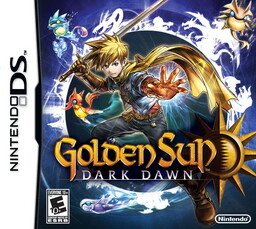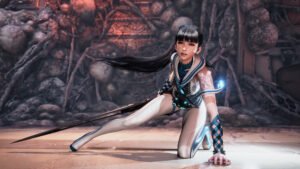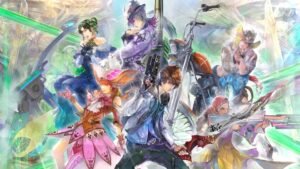Back in 2001, just a few months after Nintendo first released the Gameboy Advanced, a little gem of an RPG was released – a game called Golden Sun.
Golden Sun was a throwback to some of the great titles in the genre that were released during the Super Nintendo era like Final Fantasy VI (Final Fantasy III in North America), Dragon Quest V and Chrono Trigger.
Like the games it was trying to emulate, Golden Sun was well-received and garnered a sequel – Golden Sun: The Lost Age – that neatly wrapped up the story of the two games.
However, it seems that not all problems were solved in the land of Weyward as a new adventure has been released on the DS, Golden Sun: Dark Dawn.
Taking place 30 years after the events of the first two games, Dark Dawn has you in control of a party that mainly consists of the children of the original heroes.
There’s the main protagonist, Matthew, who’s the son of Isaac, Garet’s son Tyrell, Ivan’s daughter Karis and Mia’s son Rief, with an additional four more party characters that you will encounter.
If you played the original games and are a little antsy about the new characters, there’s no need to be because they all behave – both in terms of personality and gameplay – exactly like their parents did.
For example, just like his dad, Matthew is a silent Venus adept leader, who will, literally, not say anything while Tyrell is a brash, slightly dimwitted Mars adept just like Garet.
As far as the overall story goes, the game follows many conventions in the genre and spins a tale where one seemingly small task spirals into a larger, grander quest to save the world. If you’ve played a console RPG before, you probably already know a lot of the story arcs involved in Dark Dawn.
Because storylines don’t really change too much in RPGs, the way the tale is told is usually the differing factor – with cutscenes being the most popular choice. Dark Dawn has plenty of cutscenes, but, unfortunately, they haven’t evolved much from the text and speech bubbles of the original games. The DS is capable of pretty good looking 3D and it would have been nice to be able to see a few FMV cutscenes that many other RPGs use.
From a gameplay standpoint, Dark Dawn plays exactly like its predecessors and there’s nothing wrong with that because the basic formula that was established from the first game still works very well.
In every Golden Sun title you will find yourself doing a combination of three things: exploring, puzzle solving and battling.
Exploration works like most role-playing experiences, there’s a world map that you can move around in – and eventually a ship sail, if you’re in a town you can walk around to visit shops, talk to townsfolk for clues and search for hidden items in pots, jars and chests and there are dungeons aplenty with more goodies for you to look for.
Among the various things that you can find while taking in the sights of Weyward are the adorable creature companions called Djinn.
Djinn are a Golden Sun signature and they’re spread out all across the world for you to find. It’s in your best interest to find as many of the possible 72 that you can because they help boost the stats of your characters and can be used in battle.
Another cool part of exploration in Dark Dawn that veterans to the series will get a kick out of is revisiting some of the places you went to before in the previous games and seeing how much the landscape and people have changed.
Probably the most interesting side of any Golden Sun game’s gameplay would be the puzzle solving aspects. As you go about exploring the land of Weyward you will encounter many areas that would normally be inaccessible if not for the power of psynergy. Psynergy is essentially magic in the world of Golden Sun and it has plenty of uses outside of combat.
For example, you can use Psynergy to grow plants that can be used as ladders or even move pillars to allow you to hop across chasms.
The final key branch of gameplay is in the game’s combat. This is where Golden Sun appears most like those great RPGs of the SNES period. Battling is done in a turn-based style and within the system you can do the expected things. Make a basic attack with your weapon, use psynergy for offensive, defensive or restorative purposes or even summon a creature by making use of your Djinn allies.
New to combat in Dark Dawn is the designated weapon level system. Every weapon that you get has a mastery level with a series of powerful critical strikes called unleashes attached to them that can be unlocked as you level your weapon up. In order to power up any weapon is to repeatedly use it. So, if you want to take your weapon to its full potential, you’re probably going to want to grind it out until it’s fully mastered.
On the topic of grinding, that’s where Dark Dawn has a slight downfall with its combat system. The best RPGs will scale the encounters you face during the course of the game so there’s a good level of challenge but not enough that you feel forced to grind in order to make it past a dungeon or boss.
In Dark Dawn’s case, the difficulty is never too steep until you face the final boss. Unless you spend a good amount of time grinding out levels, the final boss is probably going to eat you alive. It’s good that the last baddie is tough, but not so tough that you have no choice but to level grind in order to win.
All-in-all, just like the original titles, the gameplay of Dark Dawn is rock solid with a good mixture of those three key elements holding it all together.
The biggest area that Dark Dawn has changed in is in its presentation. Thanks to the hardware upgrade to the DS, Golden Sun has moved on from its 2D look and moved into the third dimension.
Visually, the game uses a 2.5D look because you’re still playing the game like it was in 2D but the character models and environments are all rendered in 3D.
The look of the world is bright and vibrant with a lot of colours. The characters have a distinct anime look to them and their gigantic heads outside of battle make them look pretty cute.
Within battle is where the game truly shines graphically. There are a lot of really cool animations that you will see during the course of the game, particularly during summons where the game makes use of both screens during very flashy looking FMV sequences.
As far as the audio goes, it comes up short when compared to the visuals but it’s still pretty good. The orchestral music stands out, especially with the original Golden Sun theme making a return, however, a lack of voice acting of any kind is unfortunate. It doesn’t necessarily have to be for bits of dialogue, but even in battle it would be nice to hear something come out of the characters’ mouths to give them a little more personality.
In closing, Keeping close to what made those original games so good was an excellent call by developer Camelot and RPG fans of any ilk should be very satisfied with the experience that the game provides even if they didn’t play the previous GBA games.





